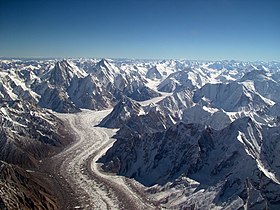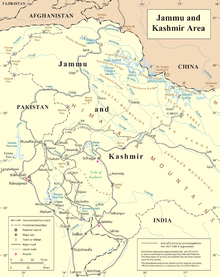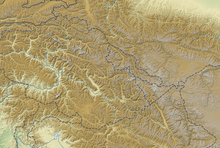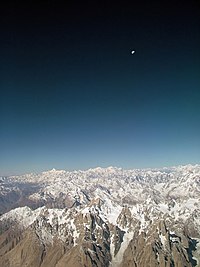Karakoram
This article is about the mountain range. For the ancient city in Mongolia, see Karakorum. For the highway, seeKarakoram Highway.
Not to be confused with Karakum.
| Karakoram | |
|---|---|

| |
| Highest point | |
| Peak | K2 |
| Elevation | 8,611 m (28,251 ft) |
| Coordinates | 35°52′57″N 76°30′48″E |
| Geography | |
Highest Karakoram peaks as seen fromInternational Space Station
| |
| Countries | Pakistan, India, China andAfghanistan |
| States/Provinces | Gilgit–Baltistan, Ladakh,Xinjiang and Badakhshan |
| Range coordinates | 36°N 76°ECoordinates: 36°N 76°E |
| Borders on | Ladakh Range, Pamirs andHindu Raj (Hindu Kush) |
The Karakoram, or Karakorum is a large mountain range spanning the borders between Pakistan, India, China and Afghanistan, located in the regions of Gilgit–Baltistan (Pakistan), Ladakh (India), southern Xinjiang(China) and the northeastern frontier of the Wakhan Corridor(Afghanistan). A part of the complex of ranges from the Hindu Kush to the Himalayan Range,[1][2] it is one of the Greater Ranges of Asia. The Karakoram is home to the highest concentration of peaks over 8000m in height to be found anywhere on earth,[3] including K2, the second highest peak in the world at 8,611 m (28,251 ft).
The range is about 500 km (311 mi) in length, and is the most heavilyglaciated part of the world outside the polar regions. The Siachen Glacierat 76 kilometres (47 mi) and the Biafo Glacier at 63 kilometres (39 mi) rank as the world's second and third longest glaciers outside the polar regions.[4]
The Karakoram is bounded on the northeast by the edge of the Tibetan Plateau, and on the north by the Pamir Mountains. The southern boundary of the Karakoram is formed, west to east, by the Gilgit, Indus, and Shyok Rivers, which separate the range from the northwestern end of theHimalaya range proper as these rivers converge southwestward towards the plains of Pakistan.
The Tashkurghan National Nature Reserve and the Pamir Wetlands National Nature Reserve in the Karalorun and Pamir mountains have been nominated for inclusion in UNESCO in 2010 by the National Commission of the People's Republic of China for UNESCO and has tentatively been added to the list.[5]
Contents
[hide]Name[edit]
Karakoram is a Turkic term meaning black gravel. The name was first applied by local traders to the Karakoram Pass.[6] Early European travellers, including William Moorcroft and George Hayward, started using the term for the range of mountains west of the pass, although they also used the term Muztagh (meaning, "Ice Mountain") for the range now known as Karakoram.[6][7] Later terminology was influenced by the Survey of India, whose surveyor Thomas Montgomerie in the 1850s gave the labels K1 to K6 (K for Karakoram) to six high mountains visible from his station at Mount Haramukh in Kashmir.
Exploration[edit]
Due to its altitude and ruggedness, the Karakoram is much less inhabited than parts of the Himalayas further east. European explorers first visited early in the 19th century, followed by British surveyors starting in 1856.
The Muztagh Pass was crossed in 1887 by the expedition of Colonel Francis Younghusband[8] and the valleys above the Hunza River were explored by General Sir George K. Cockerill in 1892. Explorations in the 1910s and 1920s established most of the geography of the region.
The name Karakoram was used in the early 20th century, for example by Kenneth Mason,[6] for the range now known as the Baltoro Muztagh. The term is now used to refer to the entire range from the Batura Muztagh above Hunza in the west to the Saser Muztagh in the bend of the Shyok River in the east.
Floral surveys were carried out in the Shyok River catchment and from Panamik to Turtuk village by Chandra Prakash Kaladuring 1999 and 2000.[9][10]
Geology and glaciers[edit]
The Karakoram is in one of the world's most geologically active areas, at the plate boundary between the Indo-Australian plate and the Eurasian plate.[11] A significant part, 28-50% of the Karakoram Range is glaciated, compared to the Himalaya (8-12%) and Alps (2.2%).[12] Mountain glaciers may serve as an indicator of climate change, advancing and receding with long-term changes in temperature and precipitation. Karakoram glaciers are mostly stagnating or enlarging,[13][14] because, unlike in the Himalayas, many Karakoram glaciers are covered in a layer of rubble which insulates the ice from the warmth of the sun. Where there is no such insulation, the rate of retreat is high.[15]
The Karakoram during the Ice Age[edit]
In the last ice age, a connected series of glaciers stretched from western Tibet to Nanga Parbat, and from the Tarim basinto the Gilgit District.[16][17][18] To the south, the Indus glacier was the main valley glacier, which flowed 120 kilometres (75 mi) down from Nanga Parbat massif to 870 metres (2,850 ft) elevation.[16][19] In the north, the Karakoram glaciers joined those from the Kunlun Mountains and flowed down to 2,000 metres (6,600 ft) in the Tarim basin.[18][20]
While the current valley glaciers in the Karakoram reach a maximum length of 76 kilometres (47 mi), several of the ice-age valley glacier branches and main valley glaciers, had lengths up to 700 kilometres (430 mi). During the Ice age, the glacier snowline was about 1,300 metres (4,300 ft) lower than today.[18][19]
Highest peaks[edit]
The highest peaks of the Karakoram are:
- K2: 8,611 metres (28,251 ft)
- Gasherbrum I: 8,080 metres (26,510 ft)
- Broad Peak: 8,051 metres (26,414 ft)
- Gasherbrum II: 8,035 metres (26,362 ft)
- Gasherbrum III: 7,952 metres (26,089 ft)
- Gasherbrum IV: 7,925 metres (26,001 ft)
- Distaghil Sar: 7,885 metres (25,869 ft)
- Kunyang Chhish: 7,852 metres (25,761 ft)
- Masherbrum I: 7,821 metres (25,659 ft)
- Batura I: 7,795 metres (25,574 ft)
- Rakaposhi: 7,788 metres (25,551 ft)
- Batura II: 7,762 metres (25,466 ft)
- Kanjut Sar: 7,760 metres (25,460 ft)
- Saltoro Kangri: 7,742 metres (25,400 ft)
- Batura III: 7,729 metres (25,358 ft)
- Saser Kangri: 7,672 metres (25,171 ft)
- Chogolisa: 7,665 metres (25,148 ft)
- Passu Sar: 7,478 metres (24,534 ft)
- Malubiting: 7,458 metres (24,469 ft)
- Sia Kangri: 7,442 metres (24,416 ft)
- K12: 7,428 metres (24,370 ft)
- Skil Brum: 7,410 metres (24,310 ft)
- Haramosh Peak: 7,397 metres (24,268 ft)
- Ultar Peak: 7,388 metres (24,239 ft)
- Momhil Sar: 7,343 metres (24,091 ft)
- Baintha Brakk: 7,285 metres (23,901 ft)
- Baltistan Peak: 7,282 metres (23,891 ft)
- Muztagh Tower: 7,273 metres (23,862 ft)
- Diran: 7,266 metres (23,839 ft)
- Gasherbrum V: 7,147 metres (23,448 ft)
The majority of the highest peaks are in the Gilgit–Baltistan region of Pakistan. Baltistan has more than 100 mountain peaks exceeding 6,100 metres (20,000 ft) height from sea level.
K-names[edit]
- K1: Masherbrum
- K2
- K3: Gasherbrum IV
- K3a: Gasherbrum III
- K4: Gasherbrum II
- K5: Gasherbrum I
- K6: Baltistan Peak
- K7: 6,934 m peak near Charakusa Valley
- K9: approx. 7,000 m peak near Trango Towers
- K10: Saltoro Kangri I
- K11: Saltoro Kangri II
- K12: subsidiary peak of Saltoro Kangri
- K22: Saser Kangri I
Subranges[edit]
The naming and division of the various subranges of the Karakoram is not universally agreed upon. However, the following is a list of the most important subranges, following Jerzy Wala.[21] The ranges are listed roughly west to east.
- Batura Muztagh
- Rakaposhi-Haramosh Mountains
- Spantik-Sosbun Mountains
- Hispar Muztagh
- South Ghujerab Mountains
- Panmah Muztagh
- Wesm Mountains
- Masherbrum Mountains
- Baltoro Muztagh
- Saltoro Mountains
- Siachen Muztagh
- Rimo Muztagh
- Saser Muztagh
Passes[edit]
From west to east
- Kilik Pass
- Mintaka Pass
- Khunjerab Pass (the highest paved international border crossing at 4,693 m (15,397 ft))
- Shimshal Pass
- Mustagh Pass
- Karakoram Pass
- Sasser Pass
The Khunjerab Pass is the only motorable pass across the range. The Shimshal Pass (which does not cross an international border) is the only other pass still in regular use.
Cultural references[edit]
The Karakoram mountain range has been referred to in a number of novels and movies. Rudyard Kipling refers to the Karakorum mountain range in his novel Kim, which was first published in 1900. Marcel Ichac made a film titled Karakoram, chronicling a French expedition to the range in 1936. The film won the Silver Lion at the Venice Film Festival of 1937. Greg Mortenson details the Karakoram, and specifically K2 and the Balti, extensively in his book Three Cups of Tea, about his quest to build schools for children in the region. In the Gatchaman TV series, the Karakoram range houses Galactor's headquarters. K2 Kahani (The K2 Story) by Mustansar Hussain Tarar describes his experiences at K2 base camp.[22]










Comments
Post a Comment